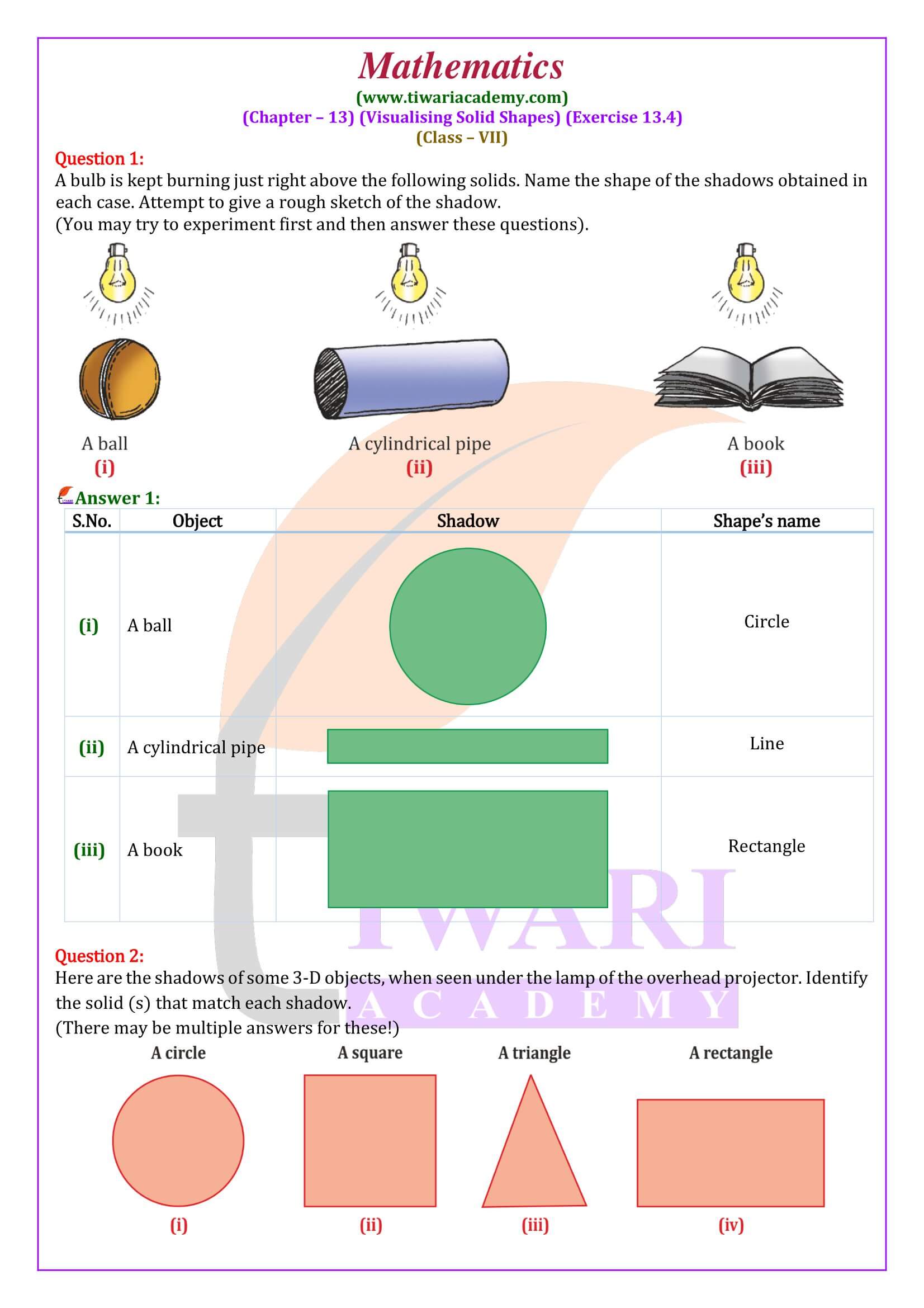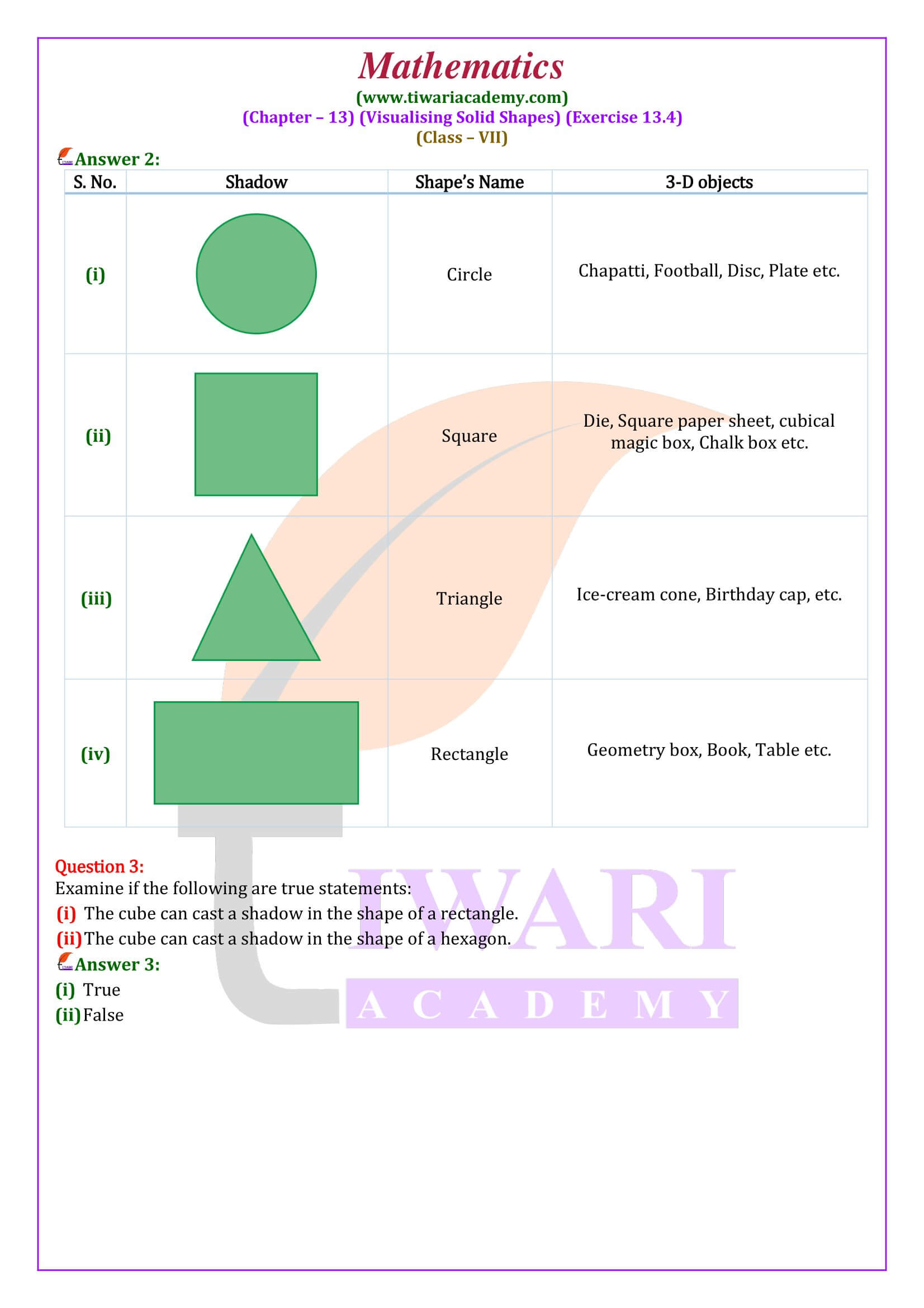NCERT Solutions for Class 7 Maths Chapter 13 Exercise 13.4 Visualising Solid Shapes in Hindi and English Medium updated for CBSE and State board session 2024-25. The solutions of ex. 13.4 class 7th mathematics are updated according to new textbook issued for academic year 2024-25.
Class 7 Maths Exercise 13.4 Solution in Hindi and English Medium
| Class: 7 | Mathematics |
| Chapter: 13 | Exercise: 13.4 |
| Topic Name: | Visualising Solid Shapes |
| Content Type: | PDF, Images and Videos |
| Academic Year: | CBSE 2024-25 |
| Medium: | English and Hindi Medium |
Class 7 Maths Chapter 13 Exercise 13.4 Solution
These solutions are useful not only for CBSE board students but the MP Board, UP Board and other state board also. In exercise 13.4 of class 7 math, we will learn the shape of the shadows of 3-D figures. The questions are based on learning by doing and easy to understand.
Class 7 Maths Chapter 13 Exercise 13.4 Solution in Videos
Class 7 Maths Exercise 13.4 Important Questions
How many right angles does a square based pyramid have?
At the base, each vertex has a right angle and two acute angles in three different planes. At the top there are four angles in different planes but their sum is less than or more than 360 deg, but never equal to 3600.
How many planes does a square pyramid have?
Originally Answered: How many faces, edges, and vertices does a square pyramid have? It has 5 faces, 8 edges, and 5 vertices. It has 5 faces, 8 edges, and 5 vertices.
What shape does 4 triangles make?
There are two layouts of four equilateral triangles that will fold to make a tetrahedron and one that will not. Get students to identify why (two of the triangles fold to be on top of each other, so there is an open side).
SQUARE PYRAMID
In geometry, a square pyramid is a pyramid having a square base. If the apex is perpendicularly above the center of the square, it is a right square pyramid. If all edges are equal, it is an equilateral square pyramid.
A triangular pyramid has
(i) A square pyramid has 5 vertices.
(ii) A square pyramid has 5 edge.
(iii) A square pyramid has 8 surface.
Net of a Three-Dimensional Figure
A net of a 3-dimensional figure is the shape that can be cut out of a plane piece of paper or cardboard and folded to make the 3-dimensional shape.
Summary
1. The circle, the square, the rectangle, the quadrilateral and the triangle are examples of plane figures; the cube, the cuboid, the sphere, the cylinder, the cone and the pyramid are examples of solid shapes. 2. Plane figures are of two-dimensions (2-D) and the solid shapes are of three-dimensions (3-D).
3. The corners of a solid shape are called its vertices; the line segments of its skeleton are its edges; and its flat surfaces are its faces.
4. A net is a skeleton-outline of a solid that can be folded to make it. The same solid can have several types of nets.
5. Solid shapes can be drawn on a flat surface (like paper) realistically. We call this 2-D representation of a 3-D solid.
6. Two types of sketches of a solid are possible:
(a) An oblique sketchdoes not have proportional lengths. Still it conveys all important aspects of the appearance of the solid.
(b) An isometric sketch is drawn on an isometric dot paper, a sample of which is given at the end of this book. In an isometric sketch of the solid the measurements kept proportional.
7. Visualising solid shapes is a very useful skill. You should be able to see ‘hidden’ parts of the solid shape.
8. Different sections of a solid can be viewed in many ways:
(a) One way is to view by cutting or slicing the shape, which would result in the cross-section of the solid.
(b) Another way is by observing a 2-D shadow of a 3-D shape.
(c) A third way is to look at the shape from different angles; the front-view, the side-view and the top-view can provide a lot of information about the shape observed.





